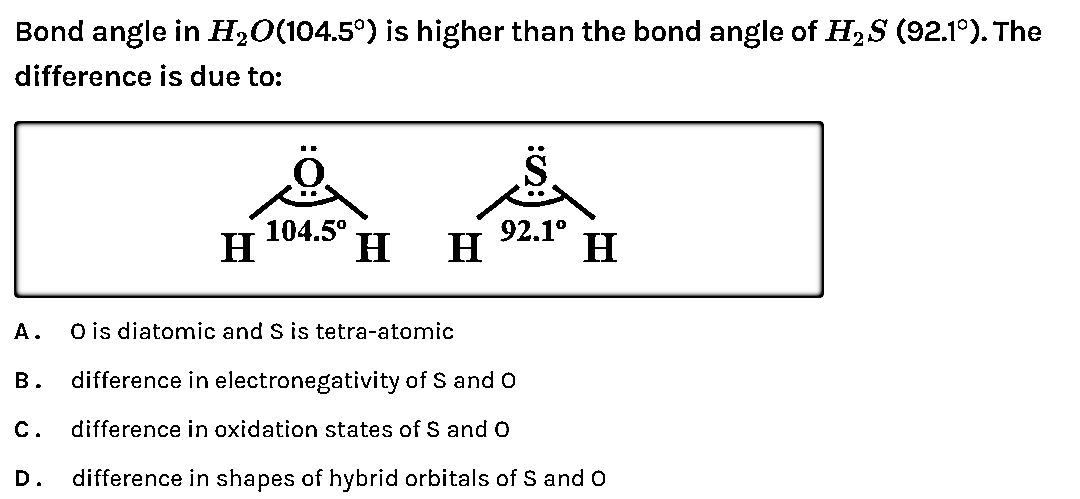
Bond angle of

A. O is diatomic and S is tetra atomic
B. Difference in electronegativity of S and O
C. Difference in oxidation state of S and O
D. Difference in shapes of hybrid orbitals of S and O

Answer
513.3k+ views
Hint: We can use the concept of electronegativity and the atomic size and the type of hybridisation.
Complete step-by-step answer:
We should explain this by difference in electronegativity. As we know that if we move down the group from O to Te, the size of the central atom goes on increasing and its electronegativity goes on decreasing.
As a result, we can observe that the position of the two bond pairs shifts away and away from the central atom as we move from
Hence the correct option is B.
Additional information:
The difference in atomic size between oxygen and sulphur impacts the sizes and energy levels of the valence shell orbitals, which in turn affects how these orbitals are being used for bonding.
Note: As we know that the electronegativity of the group 16 decreases down the group, so does their tendency to acquire two electrons to form compounds in the −2 oxidation state. The lightest member, oxygen, has the greatest tendency to form multiple bonds with other elements. Because of its high electronegativity, the chemistry of oxygen is generally restricted to compounds in which it has a negative oxidation state, and its bonds to other elements tend to be highly polar. We should remember the trend of electronegativity that is followed in group 16. Lone pair repulsion also takes place, that’s why bond angle differs in oxygen.
Complete step-by-step answer:
We should explain this by difference in electronegativity. As we know that if we move down the group from O to Te, the size of the central atom goes on increasing and its electronegativity goes on decreasing.
As a result, we can observe that the position of the two bond pairs shifts away and away from the central atom as we move from
Hence the correct option is B.
Additional information:
The difference in atomic size between oxygen and sulphur impacts the sizes and energy levels of the valence shell orbitals, which in turn affects how these orbitals are being used for bonding.
Note: As we know that the electronegativity of the group 16 decreases down the group, so does their tendency to acquire two electrons to form compounds in the −2 oxidation state. The lightest member, oxygen, has the greatest tendency to form multiple bonds with other elements. Because of its high electronegativity, the chemistry of oxygen is generally restricted to compounds in which it has a negative oxidation state, and its bonds to other elements tend to be highly polar. We should remember the trend of electronegativity that is followed in group 16. Lone pair repulsion also takes place, that’s why bond angle differs in oxygen.
Recently Updated Pages
Master Class 11 Economics: Engaging Questions & Answers for Success

Master Class 11 Business Studies: Engaging Questions & Answers for Success

Master Class 11 Accountancy: Engaging Questions & Answers for Success

Master Class 11 English: Engaging Questions & Answers for Success

Master Class 11 Computer Science: Engaging Questions & Answers for Success

Master Class 11 Maths: Engaging Questions & Answers for Success

Trending doubts
State and prove Bernoullis theorem class 11 physics CBSE

What are Quantum numbers Explain the quantum number class 11 chemistry CBSE

Write the differences between monocot plants and dicot class 11 biology CBSE

Why is steel more elastic than rubber class 11 physics CBSE

Explain why a There is no atmosphere on the moon b class 11 physics CBSE

1 ton equals to A 100 kg B 1000 kg C 10 kg D 10000 class 11 physics CBSE




